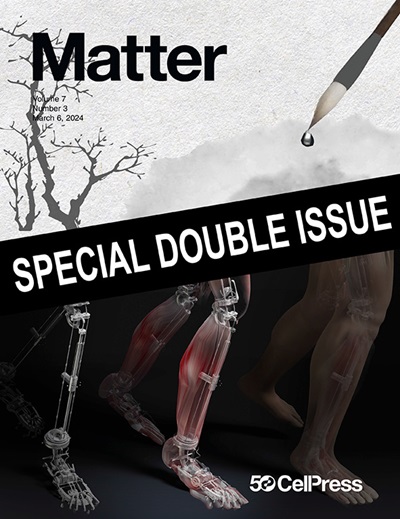通过液相透射电子显微镜解码半晶嵌段共聚物组装的演变和动力学
IF 17.5
1区 材料科学
Q1 MATERIALS SCIENCE, MULTIDISCIPLINARY
引用次数: 0
摘要
大自然利用自我组装形成复杂的功能结构,激发了先进的材料设计。聚合物结晶驱动具有有序和无序区域的组装。晶体驱动的bcp组装使独特的分层纳米结构具有增强的胶体稳定性和方向性,适用于光电子学到生物医学。然而,由于复杂的微相分离和竞争性结晶,控制形态转变的机制仍然知之甚少。利用液相透射电子显微镜,我们看到了半结晶两亲性bcp的自发组装。我们观察到结构转变,从单体到球形,圆柱形,环形胶束和囊泡通过不同的组成块比。图像分割克服了低对比度的水性组件,使运动跟踪。纳米结构表现出由形成的元素胶束在异常扩散过程中的远距离疏水相互作用驱动的结构演化。值得注意的是,与传统的bcp相比,环面形成遵循不同的途径,这是由于半晶体bcp偏爱在核-电晕界面处的低曲率。通过实时成像对装配动力学的洞察为控制复杂的分层结构提供了策略。本文章由计算机程序翻译,如有差异,请以英文原文为准。


Decoding the evolution and dynamics of semicrystalline block copolymer assembly via liquid-phase transmission electron microscopy
Nature utilizes self-assembly to form complex, functional structures, inspiring advanced materials design. Polymer crystallization drives assemblies with both ordered and disordered regions. Crystallization-driven assembly of BCPs enables unique hierarchical nanostructures with enhanced colloidal stability and directionality, applicable from optoelectronics to biomedicine. However, mechanisms governing morphological transitions remain poorly understood due to complex microphase separation and competitive crystallization. Using liquid-phase transmission electron microscopy, we visualize the spontaneous assembly of semicrystalline amphiphilic BCPs. We observe structural transformations from unimers to spherical, cylindrical, toroidal micelles, and vesicles by varying constituent block ratios. Image segmentation overcomes low contrast of aqueous assemblies, enabling motion tracking. Nanostructures exhibit structural evolution driven by long-range hydrophobic interactions from formed elemental micelles undergoing anomalous diffusion. Notably, toroid formation follows a distinct pathway compared with conventional BCPs due to semicrystalline BCPs’ preference for low curvature at the core-corona interface. Insights into assembly dynamics via real-time imaging provide strategies for controlling complex hierarchical structures.
求助全文
通过发布文献求助,成功后即可免费获取论文全文。
去求助
来源期刊

Matter
MATERIALS SCIENCE, MULTIDISCIPLINARY-
CiteScore
26.30
自引率
2.60%
发文量
367
期刊介绍:
Matter, a monthly journal affiliated with Cell, spans the broad field of materials science from nano to macro levels,covering fundamentals to applications. Embracing groundbreaking technologies,it includes full-length research articles,reviews, perspectives,previews, opinions, personnel stories, and general editorial content.
Matter aims to be the primary resource for researchers in academia and industry, inspiring the next generation of materials scientists.
 求助内容:
求助内容: 应助结果提醒方式:
应助结果提醒方式:


